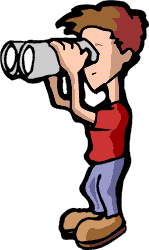Hands-on Activities: Field of View
Grade Level K-4
Essential Question How does your field of view affect what you know?
Objective Students will learn about field of view and how the size of their field of view affects the type and amount of information they obtain.
Materials a drinking straw, a paper towel roll, a tube made of poster paper taped side-to-side lengthwise (that is, long and narrow), and a tube made of poster paper taped end-to-end widthwise (that is, short and wide), paper, and pencil; shoeboxes, construction paper, scissors, tape or glue, crayons, and string (optional)
Approach
 Present the straw, paper towel roll, and two poster paper tubes to your students. Explain to the students that they will look through each of these instruments to view their surroundings. Ask them to think about how each instrument will affect their field of view. Present the straw, paper towel roll, and two poster paper tubes to your students. Explain to the students that they will look through each of these instruments to view their surroundings. Ask them to think about how each instrument will affect their field of view.
Situate your students, one at a time, along the back wall of the classroom. Instruct them to face out toward the class and look straight ahead through each of the instruments described above. Start with the instrument that has the smallest field of view, the straw. Work your way up to the instrument with the largest field of view, the short and wide poster paper tube. Make sure they DO NOT look outside of the instruments (they might need additional warning)! When they cannot fit an instrument around both eyes, tell them to close the outside eye. Ask them to describe or draw what they see through each instrument. Ask them to describe or draw what they can see when there is no instrument around their eyes.
Reflection Explain peripheral vision to the students. Describe the use of blinders on horses to block their field of view from distractions along the sides of their path. Ask the students to explain what they believe the phrase "going through life with blinders on" means.
Discuss the uses of remote sensing and the benefits of looking at things from a different perspective. One common use of remote sensing is for the prediction of weather. The line of questioning might go as follows: When weather forecasters predict the weather, where do they get their information? Do they just look outside to see what the weather is like in their neighborhood? Why would a weather forecaster in Ohio be concerned with the weather in Kansas? What tools do they use?
Students should explain that weather forecasters look at the entire nation to examine weather patterns that might be approaching their area in the near future. They should also describe the RADAR images that weather forecasters show. Often these images are superimposed over maps to show the movement of clouds, hurricanes, etc.
After the discussion students may construct shoebox ecosystems and satellite models. They can define missions for their satellites and suspend the satellites above their ecosystems to collect data. Satellite missions may include monitoring threatened species, vegetative ground cover, or weather conditions. Ask students to explain the difference between the type and amount of data they can collect from their satellite and the type and amount of data they can collect on the ground in the ecosystem. How does their field of view affect the type of data they can collect? Illustration © 2003 www.clipart.com. |











